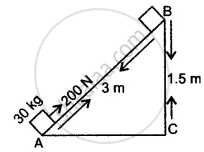Advertisements
Advertisements
Question
When is the work done by a force on a body : (a) positive, (b) negative, and (c) zero?
Solution
(a) Positive work – Work done is positive when the force aplied and the displacement caused are in same direction.
Example: When we kick a football, it moves in the direction of the force applied and hence, the work done in this case is positive.
(b) Negative work – Work done is negative when the force applied and the displacement caused are in opposite direction.
Example: Work done by the frictional force on a rolling football to decrease its motion is an example of negative work, as the direction of frictional force (acting on the ball) is opposite to the direction of the football’s motion
(c) Zero work – Work done can be zero for the following two reasons:
1. The displacement is zero.
2. The force and displacement are perpendicular to each other.
Work done by the earth on a satellite moving around the earth is zero as the direction of the motion of the satellite is always perpendicular to the direction of the gravitational force.
APPEARS IN
RELATED QUESTIONS
A force of 7 N acts on an object. The displacement is, say 8 m, in the direction of the force (see the given figure). Let us take it that the force acts on the object through the displacement. What is the work done in this case?

Give one example each in which a force does (a) positive work (b) negative work, and (c) zero work.
Choose one or more correct alternatives.
For work to be performed, energy must be ______.
- transferred from one place to another
- concentrated
- transformed from one type to another
- destroyed
Draw a neat labeled diagram to show the direction of two forces acting on a body to produce rotation in it. Also mark the point about which rotation takes place.
Does the earth move around the sun with a uniform velocity?
Name the physical quantity whose MKS units are kgm2s-3.
Fill in the boxe to show the corresponding energy transformation.

State the energy changes which take place when A toy car with a wound spring moves on ground.
Define force. Is force a scalar or a vector quantity?
State larger units of power.
A block of mass 30 kg is pulled up a slope, as shown in diagram with a constant speed, by applying a force of 200 N parallel to slope.
A and B are initial and final positions of block.

(i) Calculate the work done by force in moving the block from A to B.
(ii) Calculate P.E. gained by block. [g=10ms-2]
A coolie is pushing a box weighing 1500 N up an inclined plane 7.5 m long on to a platform, 2.5 m above the ground.
(i) Calculate the mechanical advantage of the inclined plane. (ii) Calculate the effort applied by the coolie.
(iii) In actual practice, the coolie needs to apply more effort than what is calculated. Give one reason why you think the coolie needs to apply more effort.
Look at the activity below. Reason out whether or not work is done in the light of your understanding of the term ‘work’.
An engine is pulling a train.
